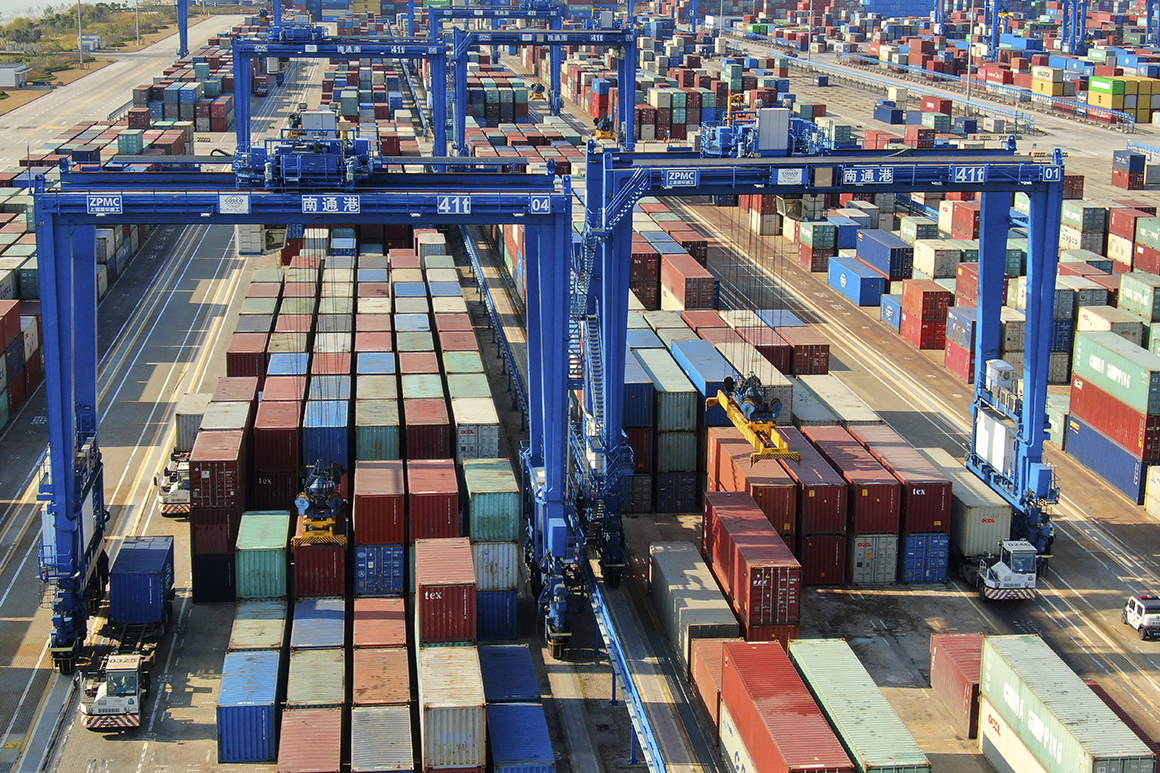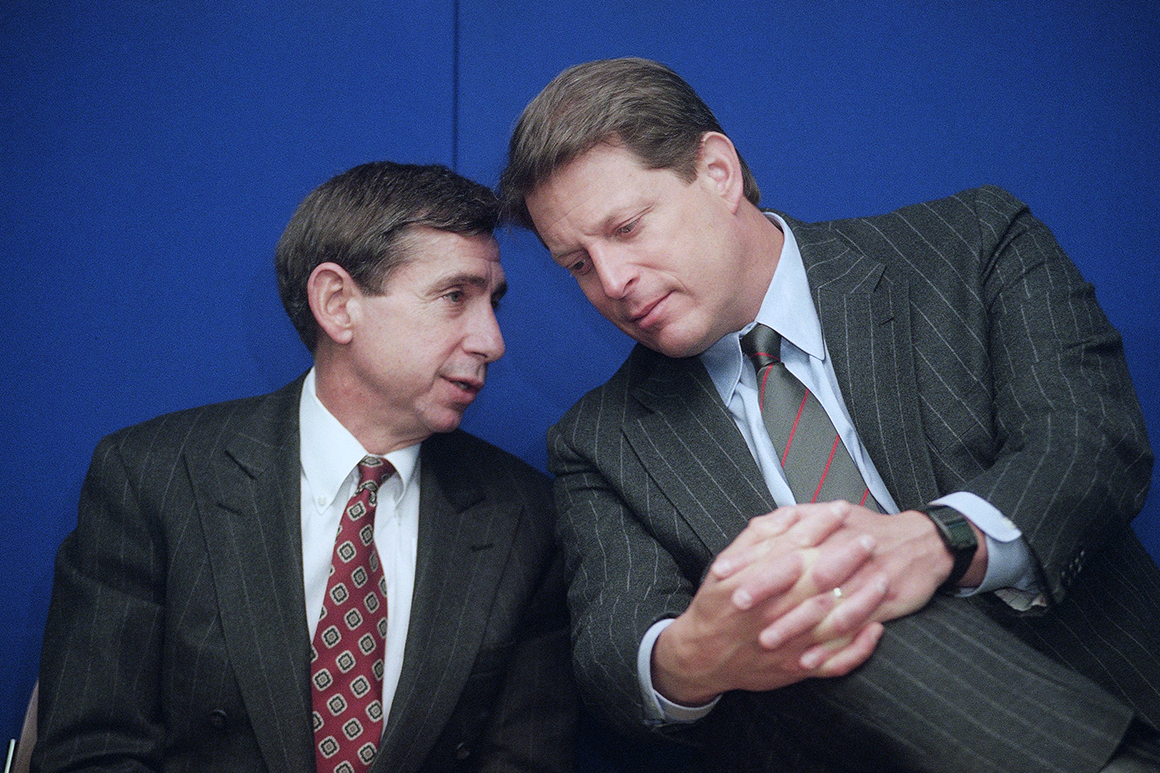
It’s been 20 years since China entered the global trade body, the World Trade Organization, a move that gave it access to the international trade system.
Was it worth it? Some officials and lawmakers have regrets, arguing that China’s gains from WTO entry on Dec. 11, 2001, came at an unfair cost to the U.S. economy.
Most U.S. lawmakers who paved the way for China’s accession to the WTO by agreeing to normalize trade relations with China through approval of Permanent Normal Trade Relations in May 2000 would rather not talk about their vote.
POLITICO canvassed eight senators still in the chamber who voted in favor of the bipartisan move, as well as one former senator who is now a state governor. The only one to respond, Sen. Chuck Grassley (R-Iowa), said in a statement that China’s WTO accession helped reduce poverty in China and benefited U.S. agriculture, but that “clearly the arrangement hasn’t lived up to our hopes of 20 years ago.”
Rep. Kevin Brady (R-Texas), who likewise supported China’s WTO accession in a House vote, also has buyer’s remorse.
“I was convinced at the time that China needs to be part of the rules-based trading system in that it would accrue to the benefit of the U.S. in a significant way over time,” Brady told reporters Tuesday. “Now it’s clear China had no intention of living within a rules-based trading system.”
But four U.S. experts who helped plan and negotiate U.S. normalization of trade ties with China that paved the way to China’s WTO accession have no such regrets. They concede neither the WTO nor the U.S. government was equipped for China’s combination of relentless exploitation of WTO loopholes with a willful disregard of WTO rules that has put China within possible reach of displacing the U.S. as the world’s largest economy as soon as 2028.
China’s WTO accession has rendered the U.S. undeniable gains. Consumers have enjoyed two decades of relatively inexpensive imported consumer goods, which boosted their buying power and the economy. A 2019 analysis by the London School of Economics of the impact of China’s WTO entry on U.S. consumer prices concluded that “each US household saw its annual purchasing power increase by $1,500 thanks to lower prices caused by increased trade with China from 2000 to 2007.”
WTO-brokered access to the Chinese market for U.S. agricultural products has reaped an export boom for farmers and agribusiness. And the U.S.-China Business Council’s 2021 member survey revealed that “ninety-five percent of respondents report that their China operations were profitable over the last year.”
But there is compelling data that China’s WTO entry helped accelerate America’s deindustrialization. A 2020 analysis by the nonprofit Economic Policy Institute, a labor-oriented think tank, estimated in January 2020 that the U.S. trade deficit with China resulted in the loss of 3.7 million jobs from 2001-2018.
The Chinese government’s willingness to push its economy to a more market-oriented setting broadly ground to a halt by around 2008. And that may have been the plan.
“When we promised to adopt a market economy, we made it absolutely clear that it would be a socialist market economy,” Long Yongtu, China’s chief negotiator for WTO accession, said in an interview in May. That effectively meant that China exploited foreign market access while blocking the U.S. from the Chinese market through measures largely outside of the WTO’s supervision and enforcement mechanisms.
POLITICO talked to four policymakers who were actively involved in the process of pushing China through the process 20 years ago. Here are their perspectives on what has happened since:
CHARLENE BARSHEFSKY
UNITED STATES TRADE REPRESENTATIVE (1997-2001)
The Clinton administration viewed China’s entry into the international trading system as a mutually beneficial opportunity to manage its economic rise. And the first few years of China’s WTO entry supported that gamble. A Report to Congress on China’s WTO Compliance in 2004 praised the Chinese government for an improving performance that made it “substantially in compliance with its [WTO] obligations.”
Barshefsky blames the administrations of former Presidents George W. Bush and Barack Obama for failing to wield the WTO tools at its disposal — specifically an import safeguard mechanism built into China’s accession agreement. That tool gave the U.S. and other WTO member states wide latitude in addressing import dumping through targeted tariffs.

“The major problem was not that China joined the WTO, but that the U.S. failed to enforce China's commitments even though in China's WTO accession agreement, we included extremely strict and unique enforcement provisions against China,” said Barshefsky.
With enforcement, “China would have understood to the extent that imports in various sectors were blocked or sharply reduced, that it couldn't do business the way it was doing business and that may have had an impact in terms of their economic model and the surges of [Chinese] imports that occurred could have been prevented in significant part.”
Despite the relative ease with which affected companies could file for safeguard measures, only three such applications were filed during the Bush administration, and the president denied all three of them “on some misplaced geopolitical calculation,” Barshefsky said.
The sole import safeguard imposed against Chinese imports before the mechanism expired in 2013 was the Obama administration’s 2009 imposition of duties on Chinese tire imports linked to the loss of 5,000 U.S. jobs.
JENNIFER A. HILLMAN
GENERAL COUNSEL AT THE OFFICE OF THE U.S. TRADE REPRESENTATIVE (1995-1997)
COMMISSIONER AT THE U.S. INTERNATIONAL TRADE COMMISSION (1998-2007)
U.S. policymakers made implicit — and often explicit — assumptions that ushering China into the global trading system would empower reformers committed to market economics and fundamental changes in China’s authoritarian one-party state.
“For some members of Congress and for some in the Clinton administration … there was a perception that there was a significant number of people in China at all levels [of government] that wanted an economically reformed China, that wanted a market economy and some that also wanted a democratic China,” said Hillman.
Still, it would not have been in the U.S. interest to block China’s entry to WTO 20 years ago, said Hillman, a professor of practice at Georgetown Law School.
“There was no way to say ‘no’ because if the U.S. had said ‘no’ and China had not joined the WTO, it would have probably engaged in a whole series of [trade] agreements that would have had the effect of discriminating against the United States,” Hillman said.
Fear of Chinese government retaliation against U.S. goods reprisals effectively stifled the use of the import safeguard mechanism built into China’s WTO accession agreement to prevent damaging flows of low cost imports, she added.
MICKEY KANTOR
UNITED STATES TRADE REPRESENTATIVE (1993-1996)
SECRETARY OF COMMERCE (1996-1997)
Successive U.S. administrations weren’t naive about the potential benefits and the challenges the U.S. faced in seeking to make China’s WTO entry a success for all its members.
“I think we were generally correct that China was going to become the second largest power on the face of the earth and if the first largest power, the United States of America, did not reach out and begin to bring China into a system of liberal order and rule of law, then everyone was going to suffer,” Kantor said.

“We knew everything would not go perfectly. President Clinton said it. President Bush and President Obama said it. No one had unrealistic expectations,” he added.
But that understanding of the challenges involved didn’t prepare Kantor for the frustrations in trying to push China into honoring its WTO commitments.
“What we had was the expectation that we’d work towards making solid, serious progress — and what has happened is the Chinese have taken that as some form of weakness,” Kantor said.
HARRY G. BROADMAN
CHIEF OF STAFF OF THE PRESIDENT’S COUNCIL OF ECONOMIC ADVISERS (1990-1991)
UNITED STATES ASSISTANT TRADE REPRESENTATIVE (1991-1993)
U.S. companies should have stepped up to call out unfair Chinese trading practices, but most did not out of fear of potential state reprisals, Broadman said.
“A lot of U.S. firms would come to us and they would complain about Chinese [imports] and say that we had to put in place safeguards, but they’d always add, ‘Don't tell the Chinese that we came to you and told you this!’” said Broadman, now at the Berkeley Research Group. “They knew that if we started punishing the Chinese in a particular sector, they were going to know that it was Company X and Company Y [that complained].”
But he cautioned against perceptions that China’s WTO entry has been a universally one-sided losing proposition for U.S. businesses that invested in China and established operations there.
“You can see that the firms who are there today were largely the firms who have been there for the last 20 years and they wouldn't be there if they were not making money,” Broadman said.
WHAT’S NEXT BEYOND WTO
There are growing calls for the U.S. to demand meaningful accountability for China within the WTO system or to pursue fairer trade terms outside of it.
“We're now at a point where Beijing is clearly in broad violation of its 2001 accession agreement,” Broadman said, proposing three options that China should be given: renegotiate its WTO membership terms, be shown the WTO “exit door,” or immediately execute its promised reforms.
Practically, however, the WTO may be incapable of bringing China’s unfair trading practices to heel because all 164 member nations — including China itself — need to accede to any new agreements.
“I don't think the WTO can adequately discipline Chinese government practices because the rules of the WTO are now old,” Barshefsky said.
Instead, Barshefsky, Kantor and Hillman urge the Biden administration to pursue a reset in its China trade relationship through membership in the Comprehensive and Progressive Agreement for Trans-Pacific Partnership, or CPTPP.
The CPTPP includes Australia, Brunei, Canada, Chile, Japan, Malaysia, Mexico, New Zealand, Peru, Singapore and Vietnam. It is the successor to the Obama-era Trans-Pacific Partnership from which former President Donald Trump withdrew the U.S. in 2017. Both China and the United Kingdom are now seeking CPTPP membership.
Kantor calls CPTPP “the best trade agreement ever negotiated” and sees it as a platform that would allow the U.S. and China to address bilateral trade irritants in a way that the WTO can’t. “CPTPP gives both countries an opportunity to begin to work on [China’s] problems like subsidies and overproduction and to resolve them,” said Kantor.
Still, a fundamental problem remains that China sees nothing wrong with its behavior.
“Over the last two decades, China has fully delivered on its [WTO] accession commitments … empowering global development and prosperity,” Chinese Ambassador to the U.S., Qin Gang, said in a speech at the U.S.-China Business Council’s annual gala last week.
And the standoff appears likely to continue under the Biden administration.
“We welcome fair competition, but not competition that tilts the playing field against our workers and our companies,” U.S. State Department Under Secretary for Economic Growth, Energy, and the Environment, Jose Fernandez, said in a blistering critique of Chinese economic practices during the same event.
Doug Palmer contributed to this report.
----------------------------------------
By: Phelim Kine
Title: System failure: How China won WTO entry and beat the global trading system
Sourced From: www.politico.com/news/2021/12/09/china-wto-20-years-524050
Published Date: Thu, 09 Dec 2021 17:34:00 EST






